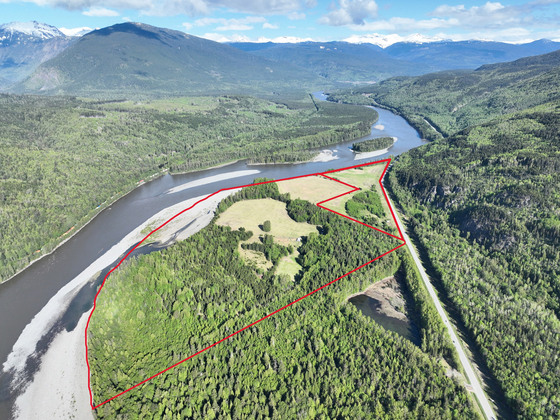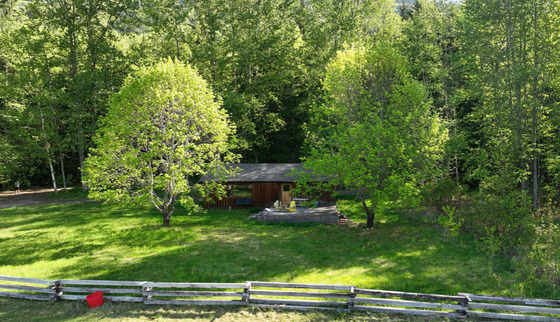Introducing a one of a kind, 175-acre off-grid farm featuring 2.1 k of riverfront along the banks of the Skeena River. 100± acres of hay with plenty of room for expansion. Awe-inspiring views to the river with a spectacular mountainous backdrop. Merchantable timber in the southern section.






 +12 photos
+12 photos
This premiere 175-acre riverfront property across two titles features 2.1 kilometres of riverfront along the banks of the world-renowned Skeena River, just 35 minutes east from Terrace, BC. With approximately 100 acres currently of hay production and room for expansion, this is a viable source of income with the high prices of hay in the area. There is also monthly income from a highway billboard adding to the value and potential for the property. The land is incredibly fertile, once a home to a thriving potato farm. The deep, rich soils make it ideal for a wide range of agricultural pursuits. Just minutes from the cabin, stroll across open fields to world class salmon and steelhead fishing on the Skeena River, a dream setting for anglers.
Surrounded by mountains the property offers spectacular vistas that highlight the rugged allure of the north. There are few places more awe-inspiring than this section of the valley. Merchantable timber covers a portion of the southern section of the property, adding long-term value and potential income.
Situated in the Agricultural Land Reserve and completely off-grid, the property includes a well-built, rustic cabin with recent upgrades. A toilet and vanity have recently been installed, and water is now available inside. The open-concept layout centers around a wood stove for efficient heating. Outbuildings include a large woodshed, oversized carport, multi-bay barn, a greenhouse and fuel shed, everything you need to get started. Whether you’re looking to start a cattle ranch, develop a self-sufficient lifestyle, or build a large-scale hobby farm, this is a rare opportunity in one of BC’s most stunning wilderness corridors.
19829 Highway16 - Terrace, BC
Driving from Vancouver to 19829 Highway 16 in the Terrace area is a long but scenic road trip through the interior of British Columbia. The journey spans roughly 1,200 kilometres and typically takes around 15 hours by car.
You begin by heading east out of Vancouver on Highway 1, the Trans-Canada Highway. This takes you through the Fraser Valley and past towns like Abbotsford and Chilliwack. At Hope, you continue north, transitioning onto Highway 97 via Cache Creek and heading toward Prince George. This portion of the drive takes you through semi-arid plateaus, forested hills, and several small interior communities.
Once you reach Prince George, you merge onto Highway 16 West, also known as the Yellowhead Highway. This highway carries you through the heart of northern BC, with long stretches of wilderness and stunning views of rivers, lakes, and mountains. You’ll pass through towns such as Vanderhoof, Burns Lake, Houston, and Smithers.
After Smithers, continue west on Highway 16 toward Terrace. The property at 19829 Highway 16 lies about 40 minutes east of Terrace, directly along the highway. This area is remote and heavily forested, so watch for the address as you approach. Cell service can be limited, so it’s a good idea to download maps in advance and travel with supplies, especially during colder months or if weather conditions are variable.
The area surrounding this property near Terrace is characterized by its rich natural beauty, and proximity to the services of Terrace, the largest community in the region. Terrace serves as the service and supply center for Northwest BC, providing essential amenities and services to the surrounding communities.
The region's climate is influenced by its location within a temperate coastal rainforest zone, resulting in mild winters and warm summers. This climate supports a diverse ecosystem, including western red cedar, western hemlock, and Sitka spruce forests. The area is also home to a variety of wildlife, such as grizzly bears, black bears, bald eagles, moose, elk and deer, river otters, martin, beaver and many more.
Culturally, the area is situated on the traditional territories of the Kitsumkalum and Kitselas First Nations, who have inhabited the region for thousands of years. Their presence is integral to the area's history and community identity.
For those interested in outdoor recreation, the region offers numerous opportunities. Activities such as fishing, hiking, and wildlife viewing are popular, with the nearby Skeena River providing excellent fishing spots. Additionally, the area is known for its scenic landscapes, making it a desirable location for nature enthusiasts.
This region is characterized by a rich and diverse vegetation typical of the inland temperate rainforest. This ecosystem is part of the Interior Cedar-Hemlock (ICH) biogeoclimatic zone, which is known for its lush, dense forests and high biodiversity. The climate in this region is influenced by its proximity to the Pacific Ocean, resulting in mild temperatures and ample precipitation, which support the growth of a variety of plant species.
Dominant tree species in the area include western red cedar, western hemlock, amabilis fir (also known as balsam), and Sitka spruce. These trees form the canopy of the forest, creating a shaded and moist environment beneath. The undergrowth is rich with a variety of shrubs and herbaceous plants, such as huckleberries, ferns, and mosses, which thrive in the humid conditions. This dense vegetation provides habitat for numerous wildlife species and contributes to the overall biodiversity of the region.
The proximity to the Skeena River also influences the local vegetation. Riparian zones along the riverbanks support the growth of cottonwoods, willows, and other moisture-loving plants. These areas are crucial for maintaining water quality and providing habitat for aquatic and terrestrial species.
The Skeena Valley offers a wealth of recreational opportunities set amidst stunning natural landscapes. Whether you're an avid adventurer or someone seeking tranquility in nature, this region caters to a diverse range of outdoor activities.
The Skeena River, renowned for its world-class salmon and steelhead fishing, is a prime destination for anglers from across the globe. Close proximity to Kitimat and Prince Rupert offers year-round ocean fishing as well. For those interested in paddling, the many nearby lakes provide calm waters ideal for kayaking and canoeing, surrounded by breathtaking mountain scenery.
The region boasts several parks and protected areas that are perfect for hiking and nature walks. Exchamsiks River Park, located approximately 56 km west of Terrace, features a 2 km loop trail through old-growth coastal Sitka spruce rainforest, offering opportunities for hiking, canoeing, kayaking, and fishing. Similarly, Kleanza Creek Park, situated about 15 km east of Terrace, provides shaded campsites and access to the Skeena River, making it a great spot for hiking and wildlife viewing.
During the winter months, the area transforms into a haven for snow sports enthusiasts. Shames Mountain, located 35 km west of Terrace, offers affordable, family-friendly skiing with both alpine and backcountry options. Cross-country skiing is also popular, with groomed trails available for both classic and skate skiing. Additionally, snowmobiling is a favored activity, with groomed trails leading to alpine areas, providing ample opportunities for exploration.
Terrace is a hotspot for mountain biking, offering trails suitable for various skill levels. The Terrace Off-Road Cycling Association (TORCA) maintains several trails, including those on Terrace Mountain and Steinhoe Ridge, providing riders with diverse terrain and scenic views. For off-road enthusiasts, the surrounding areas offer numerous trails and routes for exploration, including the Red Sands/Hart Farm area, which is popular for camping and trail riding.
The region is rich in wildlife, with opportunities to observe species such as grizzly and black bears, moose, and a variety of bird species. Local operators offer wildlife safaris and cultural tours, including visits to First Nations cultural sites and heritage parks, providing a deeper understanding of the area's natural and cultural history.
This region of the Skeena Valley is steeped in rich history, deeply rooted in the traditions of the Indigenous peoples who have inhabited this land for millennia.
The Kitselas First Nation, whose name means "People of the Canyon" in the Tsimshian language, have lived in the Skeena River Valley for at least 5,000 years. Their ancestral territory stretches from the Pacific Ocean inland to the Skeena River Valley. The heart of their community is the Kitselas Canyon, located near the Gitaus reserve, which served as a strategic stronghold where the Kitselas people historically charged tolls to travelers passing through. This area is now recognized as a National Historic Site of Canada, preserving evidence of their long-standing presence, including village sites, culturally modified trees, and artifacts.
Similarly, the Kitsumkalum First Nation, whose traditional village was situated at Dałk Gyilakyaw ("Robin Town") near the Canyon of the Kitsumkalum River, has a deep connection to this region. Their modern village lies along Highway 16, where the Kitsumkalum River meets the Skeena. Historically, many Kitsumkalum and Kitselas Tsimshians lived at Port Essington, a once-thriving cannery town at the confluence of the Ecstall and Skeena Rivers, which has since become a ghost town.
European exploration began in the late 18th century, with Russian and British fur traders venturing inland. The first sternwheeler to attempt the Skeena River was the Union in 1865, transporting supplies for the construction of the Collins Overland Telegraph line. Subsequent vessels, like the Mumford, navigated the river, facilitating trade and communication.
The construction of Highway 16, also known as the Skeena Highway, began in the early 1940s, initially serving military purposes during World War II. The highway was officially opened in 1944, though it remained a narrow, winding trail hugging the railway tracks for some time. Over the decades, the highway was paved, realigned, and improved to accommodate increasing traffic, becoming a vital transportation route for the region.
Today, the area around this property near Terrace reflects a blend of Indigenous heritage and modern development. The Kitselas and Kitsumkalum First Nations continue to play a significant role in the community, preserving their cultural traditions while engaging in contemporary economic and governance activities. Their deep connection to the land remains a cornerstone of the region's identity and history.
54°50'0.80"N and 128°19'33.33"W
None.
$408.64 (2025)
R-1
LOT 2, PLAN PRP3809, DISTRICT LOT 1373, RANGE 5, COAST RANGE 5 LAND DISTRICT, EXCEPT PLAN 6591
PID 009-970-622
LOT 3 PLAN PRP6755 DISTRICT LOT 1373 RANGE 5 COAST RANGE 5 LAND DISTRICT
PID 009-714-162
Multiple Listing Service®
 +8 maps
+8 maps
Our property descriptions and geographical information are taken from the BC Assessment Authority, Land Titles Office, government maps and other sources. While LandQuest® does not guarantee the information, we believe it to be accurate, but should not be relied upon without verification. This communication is not intended to cause or induce breach of an existing agency agreement.